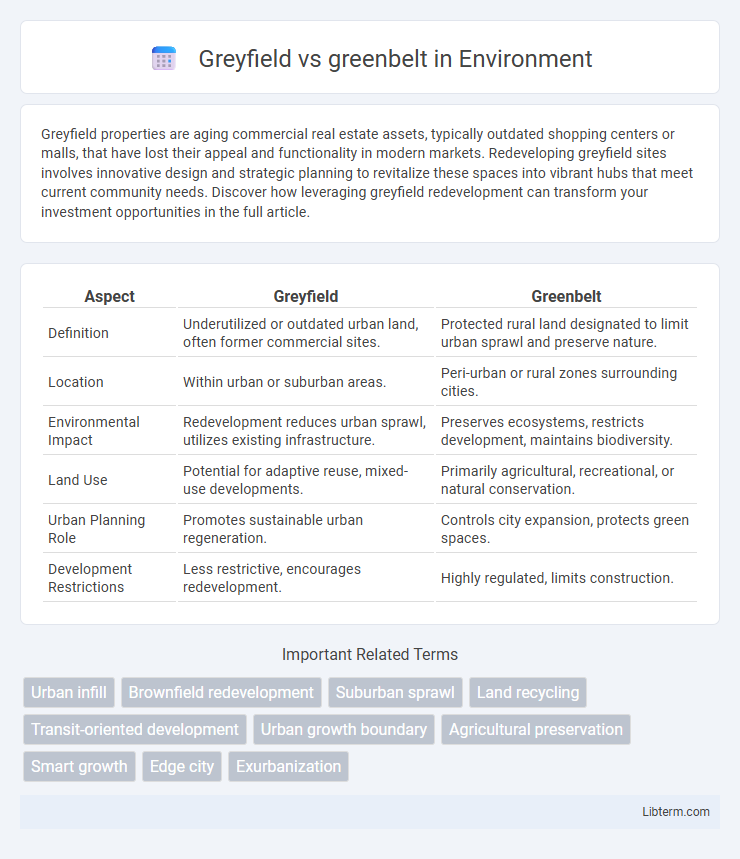Greyfield properties are aging commercial real estate assets, typically outdated shopping centers or malls, that have lost their appeal and functionality in modern markets. Redeveloping greyfield sites involves innovative design and strategic planning to revitalize these spaces into vibrant hubs that meet current community needs. Discover how leveraging greyfield redevelopment can transform your investment opportunities in the full article.
Table of Comparison
| Aspect | Greyfield | Greenbelt |
|---|---|---|
| Definition | Underutilized or outdated urban land, often former commercial sites. | Protected rural land designated to limit urban sprawl and preserve nature. |
| Location | Within urban or suburban areas. | Peri-urban or rural zones surrounding cities. |
| Environmental Impact | Redevelopment reduces urban sprawl, utilizes existing infrastructure. | Preserves ecosystems, restricts development, maintains biodiversity. |
| Land Use | Potential for adaptive reuse, mixed-use developments. | Primarily agricultural, recreational, or natural conservation. |
| Urban Planning Role | Promotes sustainable urban regeneration. | Controls city expansion, protects green spaces. |
| Development Restrictions | Less restrictive, encourages redevelopment. | Highly regulated, limits construction. |
Introduction to Greyfield and Greenbelt Concepts
Greyfield refers to economically obsolete or underutilized commercial properties, such as aging shopping malls or retail centers, that possess significant redevelopment potential. Greenbelt denotes protected open land designated to limit urban sprawl, preserve natural habitats, and maintain agricultural use. Understanding the distinct purposes and redevelopment capabilities of greyfield sites versus the conservation goals of greenbelt areas is crucial for urban planning and sustainable development strategies.
Defining Greyfield Sites: Characteristics and Examples
Greyfield sites are economically obsolete, underperforming commercial properties typically characterized by aging shopping centers with ample parking but declining business activity. These sites differ from greenbelt areas, which are protected open spaces aimed at limiting urban sprawl and preserving natural environments. Examples of greyfield locations include outdated malls like the former Dixie Square Mall in Illinois, illustrating opportunities for redevelopment and urban revitalization.
Understanding Greenbelt Areas: Purpose and Benefits
Greenbelt areas serve as designated green zones that restrict urban development to preserve natural landscapes, reduce urban sprawl, and protect biodiversity. These zones enhance air quality, provide recreational spaces, and support sustainable land management practices. Greyfield redevelopment focuses on repurposing underutilized urban properties, while greenbelts emphasize conservation and ecological benefits outside dense urban regions.
Key Differences Between Greyfield and Greenbelt Lands
Greyfield lands refer to underutilized or obsolete commercial properties, such as aging shopping centers, that present redevelopment opportunities without expansion, whereas greenbelt lands are protected areas of open space or agricultural land surrounding urban zones, designated to prevent urban sprawl. Unlike greenbelt lands, greyfields are primarily urban or suburban and often require environmental remediation and infrastructure upgrades before repurposing. Key differences include land use restrictions, development potential, and environmental impact considerations, with greyfields facilitating infill development and greenbelts serving as conservation buffers.
Environmental Impacts of Greyfield Redevelopment
Greyfield redevelopment significantly reduces urban sprawl by repurposing underutilized or abandoned commercial properties, minimizing the need to develop greenbelt areas. This process helps preserve greenbelt ecosystems that provide critical habitat, carbon sequestration, and water filtration services. However, greyfield projects may face challenges like soil contamination and insufficient green space, requiring careful environmental remediation to mitigate negative impacts.
Ecological Importance of Preserving Greenbelts
Greenbelts serve as crucial ecological buffers by maintaining biodiversity, supporting wildlife habitats, and mitigating urban heat island effects, unlike greyfield sites which are often derelict urban areas with limited ecological value. Preserving greenbelts ensures the protection of natural water cycles, air quality, and soil health, which are essential for sustainable urban environments. Urban planners prioritize greenbelt conservation to enhance ecosystem services and promote climate resilience amid growing urbanization.
Greyfield Redevelopment: Opportunities and Challenges
Greyfield redevelopment involves repurposing underutilized or obsolete commercial properties, such as aging shopping malls, to create mixed-use developments that stimulate local economies. These projects face challenges including complex financing, environmental remediation, and community opposition, but offer opportunities for urban revitalization, increased property values, and sustainable land use. Strategic planning and public-private partnerships are essential to overcome regulatory hurdles and maximize the benefits of greyfield transformations.
Policy Approaches to Managing Greyfields and Greenbelts
Policy approaches to managing greyfields emphasize redevelopment incentives, zoning reforms, and public-private partnerships to revitalize underutilized urban properties. In contrast, greenbelt policies prioritize land preservation through strict growth boundaries, conservation easements, and agricultural zoning to limit urban sprawl. Combining these strategies promotes sustainable urban development by balancing infill reuse with natural land protection.
Case Studies: Successful Greyfield and Greenbelt Projects
Case studies such as the Belmar project in Lakewood, Colorado, exemplify successful greyfield redevelopment by transforming obsolete shopping malls into vibrant mixed-use communities that boost local economies. Greenbelt initiatives, demonstrated by London's Green Belt preservation efforts, effectively limit urban sprawl while enhancing biodiversity and providing recreational spaces. Both approaches showcase strategic land use planning optimizing sustainable growth and environmental benefits.
Future Trends in Urban Planning: Greyfield vs. Greenbelt
Greyfield redevelopment projects prioritize revitalizing underutilized commercial spaces, offering sustainable urban growth by maximizing existing infrastructure and reducing sprawl. Greenbelt preservation remains essential for limiting urban expansion, maintaining biodiversity, and providing natural recreational areas that improve city resilience against climate change. Future urban planning increasingly balances greyfield revitalization with greenbelt protection to create sustainable, mixed-use developments that support both ecological health and economic vitality.
Greyfield Infographic

 libterm.com
libterm.com